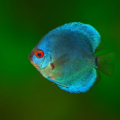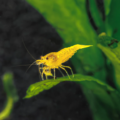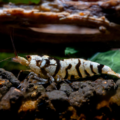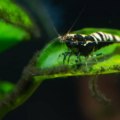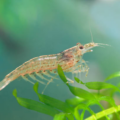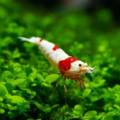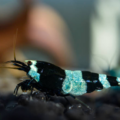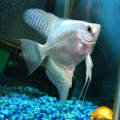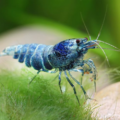Discover the beauty of Orange Eye Blue Tiger shrimp in this guide and learn the right techniques to keep them healthy and productive in your home aquarium today!

The Orange-Blue Tiger Shrimp is a unique and stunning variant of the Caridina mariae orange-eyed variant popular for its vibrant blue body, bold black tiger-like stripes, and striking orange eyes that will forever be etched in your memory.
This freshwater ornamental shrimp is a favorite among aquarists focused on adding color and elegance to their planted tanks. Its captivating appearance has made it a favorite among shrimp enthusiasts.
Now that I have whetted your appetite, let’s discuss the day’s agenda item: Orange-Eyed Blue Tiger Shrimp care.
The Stunning Appearance of Orange Eye Blue Tiger Shrimp

What should you cross off your list when identifying Orange-Eyed Blue Tiger Shrimp? I’ve got something for you!
The captivating combination of their vivid blue body and orange eye flanked by tiger-like black stripes contribute to this blue ornamental shrimp’s distinctiveness in any planted tank. With this gem in your collection, your eyes are in for a fantastic treat. (Take my word to the bank!)
Color pattern: The Orange Eye Blue Tiger Shrimp flaunts a deep, vivid blue coloration. Its bright orange eyes stand out and gently contrast the tiger-like stripes heavily present on its body.
Unique Traits
- Orange Eyes: A rare feature among typical freshwater Caridina shrimp, these stunning eyes give them their name and make them highly distinctive.
- Bold stripes: Their bold tiger-like stripes compliment the bright orange eyes, making the stand-out features and hallmarks of the tiger-striped Caridina shrimp’s alluring lineage.
Setting Up the Perfect Tank for Orange Eye Blue Tiger Shrimp

Orange Eye Blue Tiger Shrimp demand premium water conditions consisting of soft, slightly acidic water and a well-planted freshwater shrimp environment. Let’s look at more Caridina shrimp habitat tips the the rest of the section.
Tank Size and Layout
We recommend a minimum tank size of 10 gallons to begin your journey, after which you can expand your capacity depending on the amount of shrimp you intend to keep, group five per gallon. Include moss, driftwood, and rocks to provide grazing areas and hiding spots like they’re used to in their natural habitat.
Water Parameters
| Temperature | 68–74°F |
| pH Level | 6.0–6.5 |
| TDS | 120–180 ppm |
Without maintaining proper water parameters, the tank’s water quality can degrade, which can cause a wide range of issues from cloudy aquarium water to illness and mass die off.
Substrate and Decor
Opt for an active substrate to maintain stable water conditions. Natural decorations like driftwood and live plants can also enhance your Orange Eye Blue Tiger Shrimp tank setup by sharpening their color and creating a comfortable environment.
Feeding Orange Eye Blue Tiger Shrimp: Supporting Vibrancy and Health

Feeding Orange Eye Blue Tiger Shrimp is one of the most critical parts of caring for them, and I’ll help you create a balanced diet that promotes their vibrant colors and overall health. Since these blue beauties are omnivores, you have multiple food options.
Diet Suggestion
The following make up the perfect diet for vibrant shrimp
- Biofilm and natural algae
- Feeding shrimp-specific pellets or wafers is one of the hacks to enhancing shrimp color with food.
- Blanched vegetables such as zucchini, broccoli and spinach
Feeding Tips
- Provide small, frequent meals to prevent overfeeding and maintain water quality.
- Remove uneaten food after a few hours to prevent illness due to compromised water quality.
For more on feeding your aquatic pets check out The Ultimate Guide to Fish Food: Pros and Cons & Best Choices!
Breeding Orange Eye Blue Shrimp: Tips for Success
Here are some shrimp reproduction success tips for you!
The Orange Eye Blue Tiger variety is a product of the natural mutation process from Caridina mariae, or Tiger Shrimp. This means that a batch of eggs from this shrimp will produce fry of different color patterns and vibrancy.
Breeding Orange Eye Tiger Shrimp requires establishing some fundamental conditions, such as pristine water and stable tank conditions.
This video has been very helpful in identifying the sex of caridina Shrimp, I highly recommend it:
Breeding Setup
Provide clean water conditions with stable parameters. Include hiding spots like moss or caves to reduce breeding stress and collect the eggs.
Caridina Shrimp Fry Care Tips
- Feed your Orange Eye Blue Tiger Shrimp powdered shrimp food and slowly introduce blanched vegetables, biofilm for vitamins, and sharp colors.
- Maintain consistent water parameters like balanced temperature and pH level to support the growth of your shrimp fry.
Side note: The fry hatch around 30 days and will become visible.
Compatible Tank Mates for Orange Eye Blue Tiger Shrimp

Orange Eye Blue Tiger Shrimp are a peaceful freshwater aquarium species that are accommodating and compatible with other shrimp and small fish that exhibit similar traits, require similar diet options, and survive in similar water parameters.
Compatible Species
Peaceful nano fish like ember tetras, rasboras, or other Caridina shrimp are shrimp-safe tank companions for Orange Eye Blue Tiger Shrimp as they are less competitive for food and can survive in the same water conditions.
Avoided Species
Large, aggressive fish, such as Cichlids, Tiger Barbs, and Oscars, are not exactly great tank mates for Orange Eye Blue Tiger Shrimp as they have more sophisticated diet requirements that may even include your beloved shrimp and are much more competitive in a community tank, which may stress your shrimp and lead to illness.
Preventing Health Issues in Orange Eye Blue Tiger Shrimp
Maintaining healthy Caridina shrimp also involves highlighting common health issues that may affect their quality of life, including stress, molting problems, and sensitivity to changes in water parameters. However, I am here with actionable Orange Eye Blue Tiger Shrimp health tips to help you spot and address these problems on time.
Signs of illness
- Inactivity: You may notice fish exhibiting slow swimming and reduced movement in the tank.
- Failed Molts: The shrimp’s molt may not fully form or may appear deformed.
- Loss of color: You will notice that your shrimp’s hue saturation is lower than expected.
Preventative Measures
- Regular water changes are helpful in preventing shrimp illnesses.
- Establish stable parameters by keeping the temperature and pH at optimum levels at all times.
- Avoid copper-based medications, as they are toxic to shrimp and may cause death or sickness.
Lifespan of Orange Eye Blue Tiger Shrimp: Caring for Long-Term Companions

With proper care, pristine water conditions, and a stress-free environment featuring live plants, hiding spots, and friendly tank mates, expect your Orange Eye Blue Tiger Shrimp to beautify your tank for 1-2 years.
Lifespan Factors: Key factors crucial to the long-term care for shrimp include maintaining clean water, stable water parameters in the tank, and providing a balanced diet. With this trio, you’ll record an optimized experience.
Care Tips for Longevity
- Observe their behavior regularly and address any signs of stress or illness promptly.
- Normalizing proactive maintenance is another way to extend the lifespan of Orange Eye Blue Tiger Shrimp is to normalize proactive maintenance. This includes changing their water regularly, cleaning up the tank as soon as they’re done feeding to reduce waste, and quarantining new additions before introducing them to the tank.
Conclusion
The Orange Eyed Blue Tiger Shrimp is a standout addition to planted tanks, offering a unique appearance with vibrant colors and gorgeous stripes.
This is why my Orange Eyed Blue Tiger Shrimp guide is an excellent way to learn all the ornamental shrimp success tips, including stable water conditions, a balanced diet, and a peaceful environment to promote shrimp health and development.
Whether you’re a clueless beginner or an experienced aquarist. This ultimate blue and orange shrimp care guide is here to answer all your lingering questions.

